|
ARBOR Technology Gladius GT-500 and GT-500-V
Tough and impressively rugged 5-inch Android handheld computer with WorldMode communication for mission-critical deployments anytime and anywhere
By Conrad H. Blickenstorfer; photography by Carol Cotton
Share on:




ARBOR Technology, a Taiwan-based ISO-9001 certified embedded and networking manufacturer founded in 1993, announced the Gladius GT-500 early 2016 as a modern, general-purpose rugged Android handheld computer with comprehensive communications capabilities and integrated barcode scanner. Intended uses are, among many others, warehouse management systems, postal and shipping operations, government deployments, and public safety applications. RuggedPCReview has had a chance for extended hands-on with the Gladius GT-500, and this report presents our review and observations.
This review also includes references to 2018 updates to the Gladius GT-500 platform, as well as the introduction of the Verizon-approved Gladius GT-500-V.
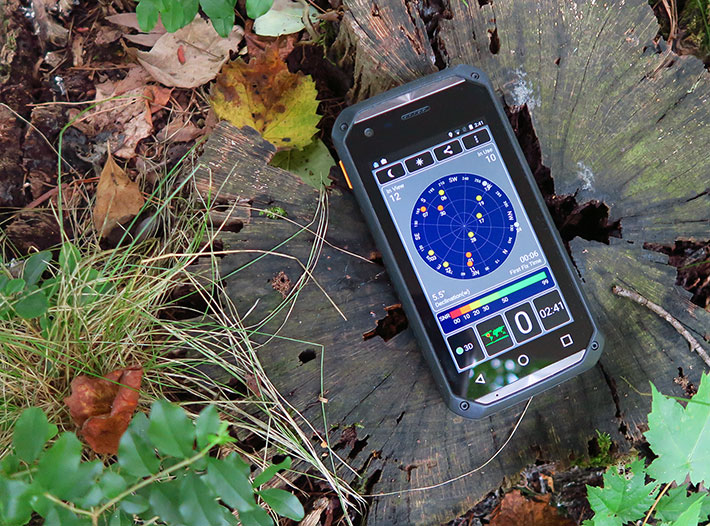
Contemporary smartphone footprint, but much tougher
Size has always been a vexing issue for designers of mobile computing devices. In theory, the larger and brighter the display, the higher the performance, and the longer the battery life, the better. In practice, many desirable features and qualities are mutually exclusive. Cost and weight are factors, too, and then there are fashion trends that can go to ridiculous extremes.
With the Gladius GT-500 ARBOR created a device very much in line with the concept of the original Pocket PC that Microsoft launched in the late 1990s. Small enough to fit into a pocket, large enough for real work, and sturdy enough to go along for the ride. But while Microsoft back then nervously wing-clipped the power of the Pocket PC so as not to snag sales from larger "real Windows" computers, makers of modern Android devices don't have such limitations. They create whatever, in their opinion, works best for their customers, and whatever makes the most sense.
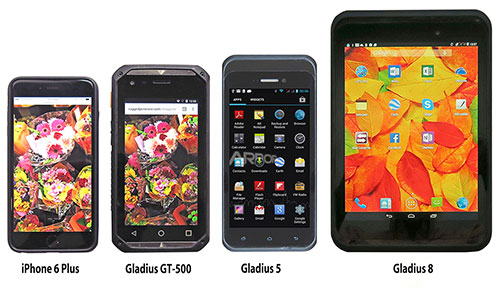 In the case of the Gladius GT-500 that meant a handheld that's the size of a contemporary smartphone, but tougher and including features that extend functionality on the job and into the field. In the case of the Gladius GT-500 that meant a handheld that's the size of a contemporary smartphone, but tougher and including features that extend functionality on the job and into the field.
The picture to the right shows where the Gladius GT-500 fits in terms of size. The lineup shows — from left to right and in scale — Apple's 5.5-inch iPhone 6 Plus, the 5-inch Gladius GT-500, ARBOR's thinner and lighter-duty 5.5-inch Gladius 5 IoT handheld, and, for comparison, ARBOR's 8-inch Gladius 8 tablet.
The Gladius GT-500 measures 6.5 x 3.4 inches, versus the iPhone 6 Plus's 6.2 x 3.1. Its 5-inch diagonal screen size is a bit smaller than those of the 6 Plus or the Gladius 5, but dwarfing phones and handhelds of just a few years ago when 3.5-inch screens were the norm.
Screen size isn't everything, of course. As a ruggedized device, the Gladius GT-500 is almost an inch thick, and weighs 13.6 ounces, close to a pound. That's substantially thicker and heavier than today's consumer smartphones (though much smaller than the Apple Newton MessagePad that was the forefather of today's smartphones and handheld computers).
With the Gladius GT-500, ARBOR now gives customers in the market for a handheld in this size class two choices. The Gladius 5 fully adopts the smartphone look and feel, but it's tougher than consumer devices and ARBOR positioned it as tool for emerging IoT applications. The GT-500 is thicker and heavier, and looks the part of a general purpose handheld computer for all sorts of deployments in the field.
Gladius GT-500 technology
With the Gladius GT-500 specifically designed as a tough, solid handheld mobile computer with worldwide appeal, what specs and technologies did ARBOR employ to help the device address all these target requirements?
 Processing power is supplied by a 64-bit 1.3GHz quad-core Cortex-A53 (the successor to Cortex-A7) MediaTek MT6735 processor that's based on the ARMv8-A instruction set. It also includes an ARM Mali-T720 GPU running at 600MHz. Processing power is supplied by a 64-bit 1.3GHz quad-core Cortex-A53 (the successor to Cortex-A7) MediaTek MT6735 processor that's based on the ARMv8-A instruction set. It also includes an ARM Mali-T720 GPU running at 600MHz.
The MT6735 was introduced in mid-2015 as a "WorldMode" smartphone platform enabling devices to seamlessly roam across high-speed 4G LTE networks uninterrupted, merging 2G, 3G and 4G technologies by supporting FDD/TDD-LTE, WCDMA, CDMA2000, TDS-CDMA, EVDO, GSM, and EDGE. It employs contemporary 28nm process technology and is used, among other devices, in various Acer Liquid Series smartphones. In our benchmark testing, the GT-500 scored roughly on par with the MT8392-equipped Gladius 10 tablet, and was significantly faster than the MTK8382-based Gladius 8.
 There's 2GB of LPDDR RAM and 16GB of eMMC for mass storage. While 16GB doesn't look like much at a time where Apple is giving up on 16GB iPhones, it's more than adequate if the device can use expansion cards. So for the Gladius GT-500 it's the 16GB, plus up to another 32GB in the user-accessible micro SDHC card slot inside the battery compartment. There's 2GB of LPDDR RAM and 16GB of eMMC for mass storage. While 16GB doesn't look like much at a time where Apple is giving up on 16GB iPhones, it's more than adequate if the device can use expansion cards. So for the Gladius GT-500 it's the 16GB, plus up to another 32GB in the user-accessible micro SDHC card slot inside the battery compartment.
There is a 13mp documentation autofocus camera with LED flash on the backside. Customers also get an additional 2mp vidcam in the front for video calls and conferencing.
Like most modern smartphones and tablets, the GT-500 comes with a bevy of sensors. That includes ambient light and proximity sensors, a 3-axis accelerometer, a 3-axis magnetic field sensor, and a barometer. Not all apps take advantage of all of these, but their presence may come in handy for custom apps.
The Gladius GT-500 has a user-accessible and easily removable 17.8 watt-hour Li-Ion battery. That's a full 70% more capacity than what the iPhone 6S Plus has, so battery life ought not be a problem here. Charging is via a standard micro-USB port or desktop docking station.
While the Gladius GT-500's 5-inch display is a bit smaller than the largest displays found on modern smartphones, it is larger than most industrial handheld screens. It's certainly large enough even for mapping and GIS applications.
This being an Android device, it's no surprise that the Gladius GT-500 uses the projected capacitive ("procap") multi-touch technology pioneered in smartphones, rather than the resistive digitizer of almost all older handhelds and still used in a good number of more recent ones.
While capacitive multi-touch in industrial devices is still new (and only came after much discussion of the technology's pros and cons), it's now pretty much standard, and especially so on Android devices.
Wired connectivity is via OTG-compatible micro-USB 2.0. For wireless connectivity there is Bluetooth v4.1, dual-band 802.11a/b/g/n WiFi, NFC, global positioning supporting GPS/GNSS/Beidou, and, of course, that "WorldMode" mobile broadband mentioned above.
The picture to the right shows the Gladius GT-500 from the front and from all four sides. It's an attractive design that merges the all-black glossy look of a modern consumer smartphone with all-business protective rubber-cladding, meticulous sealing, and space for the big battery and industrial grade expansion scanning.
Going around the Gladius GT-500 you find a small number of physical controls but not much in terms of ports. This is a sealed device, and that means the fewer openings that must be protected against immersion the better.
The left side has a volume controls and a yellow scanner button. There's also the micro-USB port with its protective plug that has its own yellow replaceable o-ring seal. On the right side is the unit's power button and another yellow scanner button. On top is the scanner window, and next to it, beneath a protective hinged rubber plug, the unit's earphone jack.
The front of the Gladius GT-500 is dominated by the large display whose surface glass extends well beyond the perimeter of the LCD, a characteristic common to virtually all capacitive touch devices, so that fingers do not bump into a border during touch. The protective rubber cladding of the Gladius GT-500 does make for a border around the perimeter of the device, but it's far enough away from the extent of the LCD to not get in the way, and it only sticks up by a couple of millimeters or so.
Beneath the display are three Android controls (Back, Home, Open Apps), implemented here as capacitive touch areas with icons outlined in white. That's a bit different from the Menu, Home, Back layout of the Gladius 5.
Gladius GT-500: design and construction 
Today's smartphones are computers, and they are more popular than ever. A staggering two billion smartphones are used around the globe. Most of them are waver-thin consumer phones that all look practically the same — rectangles that are too large to easily fit into pockets and too thin to withstand abuse. That makes absolutely no sense, but for now it's the way it is.
Industrial handhelds like the Gladius GT-500, on the other hand, are very much tools for the job. They remain mobile computers where form does follow function, a concept that the makers of consumer smartphones seem to have completely forgotten. Kudos to ARBOR Technology for providing the features and technology virtually all customers have come to expect from a modern handheld, but in a package that makes sense for working professionals who don't have the time nor inclination to baby their handheld out there on the job.
The pictures below show the backside of the Gladius GT-500, what it looks from the outside (left), an then from the inside (right). The nicely contoured backside are a welcome change from the featureless flatness of any contemporary smartphone. Screws are in plain sight, which adds a nice mechanical touch to the design and also makes it so much easier to open the housing should the need ever arise.
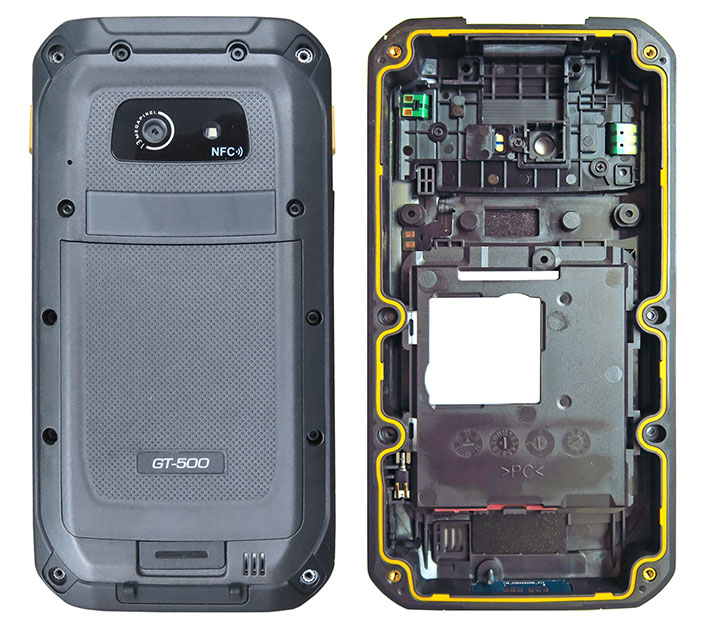
The poly-carbonate housing has fused black rubber overmoldings that make the device grippier and easier to hold, and they also provide extra protection. Sealing between the two halves of the GT-500 housing is via an elaborate tongue-and-groove design that uses a precision-cut bright yellow replaceable seal for best possible protection.
The GT-500's battery is replaceable and externally accessible. The polycarbonate battery compartment cover has its own replaceable yellow rubber seal, but here it serves as a friction seal rather than a tongue-and-groove seal, and for that we'd much rather see a conventional o-ring with a round cross section. A rectangular cross section is prone to twisting and thus losing its sealing properties, which is important here as the inside of the battery compartment is open to the interior of the device.
The battery compartment cover is held in place with a slider lock that clicks into the open or locked positions. The battery is a 3.7 Volt, 4,800 mAH Lithium-Ion design that provides 17.8 watt-hours. The spec sheet doesn't list an estimated run-time on a charge. Given that the smaller 13.3 watt-hour battery in ARBOR's Gladius 5 handheld is listed as good for up to 8 hours, we assume that the GT-500 battery with its extra 33% watt-hour should be good for at least a full shift.
Inside the battery compartment, beneath the battery, are the GT-500's dual micro-SIM slots as well as the unit's microSD card slot. Of the two SIM slots, one is for 2G only, one 2G/3G/LTE. The microSD card is of the SDHC variety and can handle cards up to 32GB.
In terms of overall construction, just like the Gladius 5, the Gladius GT-500 has a rigid magnesium frame attached to the front part of its polycarbonate housing, with the display mounted on one side of the frame and the main and subsidiary boards mounted on the other.
The two halves are secured together via 12 Torx head screws. Once those are undone, the two halves separate easily, with no wires that could break or come loose between them. Instead, ARBOR is using surface mount pressure contact (speakers and antennae are examples).
The image below shows what it looks like inside the Gladius GT-500:
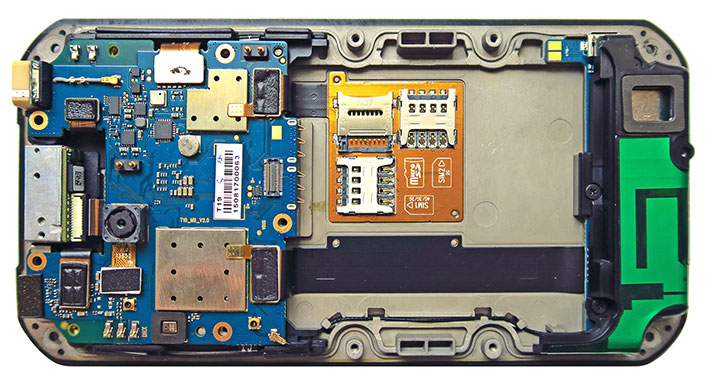
As you can see, it's a comparatively simple and very clean layout with an absolute minimum of wires than can get in the way or come loose. Note the cutouts and conduits in the magnesium frame, and also how ARBOR's designers made sure the screws that hold the device together are actually outside the seal. That way, there is no danger of water penetrating through screw holes, which we've seen on many other devices.
Unlike consumer products where scanning is done via 3rd party apps that use the integrated camera, the Gladius GT-500 relies on an integrated industrial-grade miniature scan engines, the Zebra SE4710 1D/2D imager (see SE4710 info). The GT-500 comes with a barcode scanning wizard app that provides functionality similar to Zebra's DataWedge or Honeywell's ScanWedge.
The image compilation below shows some of the interesting details of the ARBOR Gladius GT-500. On the left you can see a close-up of the intricate camera module sitting next to the tightly integrated scanner module. To the right of it the block with the SD and SIM cards, then the tiny vibration motor next to the intricate yellow rubber seal, and finally the amazing detail of the magnesium frame with guides both for seals and also for wiring.

Like the other ARBOR mobile computers we've had in our lab, the Gladius GT-500 is a remarkably clean and well organized design. Particularly impressive is the elegant, functional magnesium frame with its custom-designed main and subsidiary boards that together form a compact, logical, and very clean solution.
The Verizon-approved Gladius GT-500-V model
As of 2018, ARBOR offers the Gladius GT-500-V in addition to the standard Gladius GT-500. The "V" refers to the fact that the model is verified by Verizon, the largest wireless telecommunications provider in the United States with about 150 million subscribers.
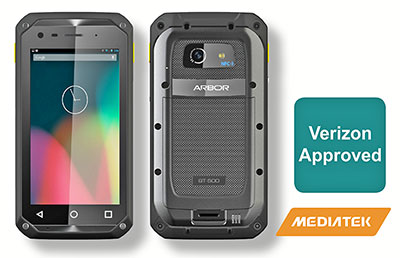 Why is there a separate model for the Verizon network? And where does certification come in? Well, Verizon has something called Verizon Wireless Open Development. It is a program that encourages developers to create new products, applications and services in addition to what Verizon Wireless itself offers. Why is there a separate model for the Verizon network? And where does certification come in? Well, Verizon has something called Verizon Wireless Open Development. It is a program that encourages developers to create new products, applications and services in addition to what Verizon Wireless itself offers.
There's a Verizon certification process that's conducted by approved external test labs. FCC-approved devices are tested and certified for compliance with Verizon's Wireless Open Development requirements for LTE. In essence, the testing makes sure that a device fully adheres to Verizon's technical network specifications and won't cause interference with other spectrum users or jeopardize network security. And the ARBOR Gladius GT-500-V has this official 4G LTE Verizon certification.
But don't AT&T and Verizon, the two largest wireless telecommunications providers in the US, use different wireless technologies altogether? Yes and no. Before 4G networks, AT&T used incompatible GSM/GPRS/EDGE and Verizon CDMA/WCDMA technologies. When 4G/LTE came along, both camps used LTE (Long Term Evolution), albeit not necessarily the same LTE bands. AT&T is using LTE bands 2, 4, 5, 12, and 17, whereas Verizon uses 2, 4 and 13. With its WorldMode modem capabilities, the GT-500 platform inherently supports all of these technologies, but the FCC (and Verizon) still have certification requirements.
All that said, there are some small differences between the standard GT-500 and the GT-500-V. Whereas the original GT-500 had dual SIMs, one for 2G and one for 2G/3G/LTE, the Verizon version only has one SIM socket and LTE band 2, 4, and 13 support. The battery packs 19.8 watt-hours instead of 17.8, and there is an extended 29.6 watt-hour battery available. RAM is up to 3GB from 2GB in the standard GT-500, and the Verizon version gets a 5MP frontal camera instead of just 2MP.
Contemporary display — 5-inch and procap multi-touch
The Gladius GT-500's 5-inch display would have looked very large for a handheld just a few years ago. The iPhone launched the modern smartphone era with a 3.5-inch screen in 2007, selling tens of millions, and it wasn't until 2012 that Apple introduced the iPhone 5 with a larger 4.0-inch screen. Since then, of course, the consumer smartphone screen size grew to the current 4.7 to 5.5 inches.
As a result, the Gladius GT-500 display now looks just about right — not too large but also not too small to work on. It helps that the Gladius display is crisp and sharp. The screen's 1280 x 720 pixel resolution is not quite as high as the full 1920 x 1080 pixel 1080p screen of the 5.5-inch iPhone 6 Plus, but 294 pixels per inch is still super-sharp and actually beats all of Apple's retina iPads and MacBooks save the iPad mini Retina (324 pp). It's much sharper than the original iPhone (163 dpi), and even the 5K Retina iMac27 this review was written on (218 dpi). And it's an IPS (In-Plane Switching) screen, which means it has perfect viewing angles from all directions, without any color or contrast changes.
The pictures below show a comparison between an iPhone 6 Plus and the Gladius GT-500 outdoors, both at automatic brightness. Apple's big 6 Plus is said to have a maximum screen brightness of 550-600 nits. The Gladius 5 specs claim 400 nits, but under most conditions, the Gladius looks as, or almost, as bright. Both displays are glossy, so there are reflections outdoors. Most smartphone and tablet users have learned to live with that.

Capacitive multi-touch works as everyone expects from a handheld these days — quickly and effortlessly. The touch controller ARBOR used is more sensitive than that in most earlier capacitive touch devices. That means it can work when wearing certain types of thin gloves. The device doesn't come with a stylus and ARBOR doesn't offer an optional capacitive pen. Any 3rd party capacitive pen will work, though those generic pens with their broad tips don't offer much more accuracy than the tip of a finger. It's not that important anyway as Android was specifically developed for capacitive multi-touch with a finger.
Android versus Windows Mobile or Windows 10 IoT
The Gladius GT-500 runs Android 5.1 "Lollipop." According to the Android Developers page, as of July 11, 2016, Lollipop had a 35.1% marketshare among all Android versions in June 2016 (see latest figures), the largest of any Android platform versions (ver. 4.4 "KitKat" was second with 30.1%). Lollipop introduced enterprise-strength security to Android, moving the platform a big step forward. Note that unlike with many recently introduced industrial handhelds, ARBOR does not offer a corresponding Windows or Windows Mobile based version. Why?
That's because in consumer markets, a great majority of non-Apple smartphones run Android, and even compared to Apple, Android has a commanding market share. And even though Windows Embedded Handheld remains strong in industrial markets, Android  is making significant inroads there as well. As a result, many providers of rugged handhelds now offer both Microsoft and Android based versions of their devices or are leaning towards Android. ARBOR's stated position is to offer whatever OS platform is best suited best for a certain type of device and application; the company offers both Android and Windows in different models of its growing rugged tablet lineup. is making significant inroads there as well. As a result, many providers of rugged handhelds now offer both Microsoft and Android based versions of their devices or are leaning towards Android. ARBOR's stated position is to offer whatever OS platform is best suited best for a certain type of device and application; the company offers both Android and Windows in different models of its growing rugged tablet lineup.
As far as Windows goes, note that Windows 10 IoT Mobile Enterprise is supposed to be, at last, the successor of Windows Mobile and Windows Embedded Handheld. It supports both the x86 and ARM architectures. The big advantage will be that any binary written for the Windows 10 unified core can run on Windows 10 IoT Mobile Enterprise.
For now, given Android's massive market share in handhelds, Android-based work devices have instant appeal and familiarity to those who already use Android smartphones and/or tablets at home or at work. Though often customized by voice and data service providers, the basic workings of the Android interface are very widely known by now, and a very large number of apps are available for download. Android software development and expertise is commonly available, and making Android devices available on the job can save training as well as deployment costs.
Upgrade from Android 5.1 to Android 7
In January 2018, ARBOR upgraded the Gladius GT-500 platform from its original Android version 5.1 to Android 7, codenamed "Nougat." As of the writing of this update to this article, April 26, 2018, according to the developer.android.com website, Android 5.1 has 18.0% marketshare (all Android 5.x "Lollipop" versions combined 22.9%), and Android 7.0 has 23% marketshare (all Android 7.x "Nougat" versions combined 30.8%). Newer is better, of course, and with "Nougat," the Gladius GT-500 platform is now up-to-date as far as the OS goes. There's Android 8.x "Oreo," but its marketshare is still under 5%.
What are the advances of Android 7 over Android 5? Overall, Android 7.0 improves device performance and operation in many subtle ways. Optimized management of background processes means more reliable operation, system updates are faster, and the way all those many notifications work has been streamlined and improved. Split-screen operation is available now, the settings menu has been redone (again), and optimized power management with an improved doze mode allows the device to perform better and run longer between charges.
Kudos to ARBOR for upgrading the GT-500! Not every manufacturer does that.
Additional Android contemplations
This section is not specific to the Gladius GT-500; it's a general assessment of Android suitability and appeal in vertical and industrial markets.
Undeniably, the total number of available apps for a handheld software platform has become a crucially important marketing issue, as is how easily users can download apps. Apple has its slick and massive App Store. Android offers the official 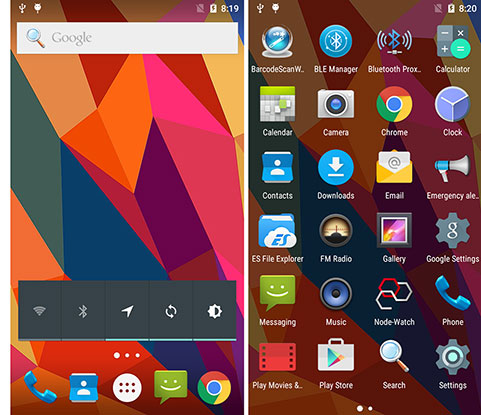 Google Play store, as well as third party alternates such as the Amazon Appstore for Android, Slide ME, and several others. Google Play store, as well as third party alternates such as the Amazon Appstore for Android, Slide ME, and several others.
There is, however, an important difference between consumer and industrial markets here. Whereas a vast number of easily accessible apps is a big plus for consumers, many industrial and enterprise deployers do not want their workforce download (and distracted by) apps into devices used for work. What are the answers to this potential problem?
One approach is to use Android AOSP, which stands for Android Open Source Project, and is an open-source software stack and project, led by Google itself, but without the ability to use the Google Play store and some of the major Google apps. Android AOSP, however, still has access to alternate app stores.
Another possibility is using something like 42Gears.com's SureLock. SureLock replaces the Android desktop and allows control of applications that are available to users. It can even be configured to run in "kiosk mode" with just a single application that is always active. This way, systems integrators or IT personnel can configure units for specific use and applications, eliminating the temptation that comes with a full load of consumer apps.
The Gladius GT-500 review sample unit ARBOR sent us for evaluation came not only with a basic selection of useful apps, but also with the official Google Play store. That's because the GT-500 is one of the relatively few enterprise handhelds with Google GMS (Google Mobile Services) certification. This generally means it's certified to run Google-branded apps (such as Maps, Gmail, Drive, etc.) and has access to the Google Play store.
Vast supply of applications
One of the benefits of Android's controlling marketshare in smartphones is the huge and constantly growing number of applications readily available for download. That's certainly a major attractions of Android compared to, say, Windows Phone, which never really got off the ground. Most of the apps are surprisingly polished and many are still free (if you can put up with obnoxious, intrusive ads or incessant nagging about upgrading to "pro" versions).
Specialized and more complex applications, of course, may require custom software development, but chances are that an inexpensive app can be found for almost everything else. By now everyone knows about the vast variety of available smartphone apps and how useful they can be, but we still like to show a few examples, illustrating how today's combination of inexpensive, innovative software and high-powered, flexible hardware can not only entertain, but greatly enhance productivity.
Web browsing, for example, used to be, to put it mildly, painful on handheld computers. Not anymore. With super-sharp displays, lightening-quick zooming in and out, and plenty of processing powers, browsing is hugely useful on handhelds today (and we wish web designers should stop forcing dumbed-down "mobile" sites on handheld users!)
Then there's Microsoft Office, still a must-have for many corporate users. An Office 365 client is available for Android, and while it is not a complete implementation of the full Office 365, it is far more comprehensive than the "mobile" versions of Word, Excel and PowerPoint Microsoft used to offer.
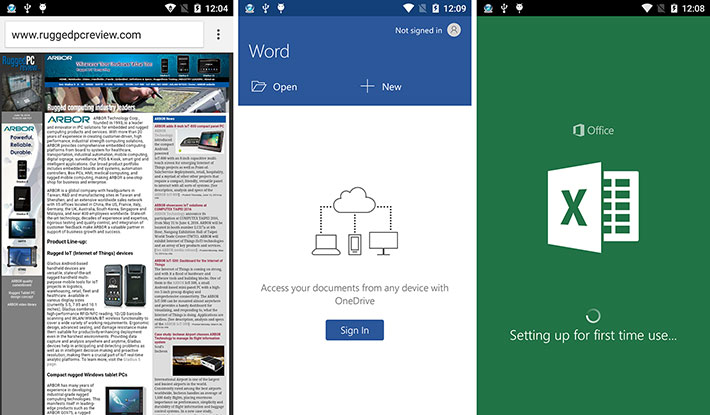
Staying with productivity for a minute, one of the first things we always download into a new Android device is Microsoft's OneDrive to access cloud storage. It's great to have access to all your relevant files no matter where you are. Another super-handy utility we can't live without is a good unit converter (see the obnoxious ad at the bottom of this "free" version though). High display resolution has also made it possible to download virtual instruments and meters for just about anything.
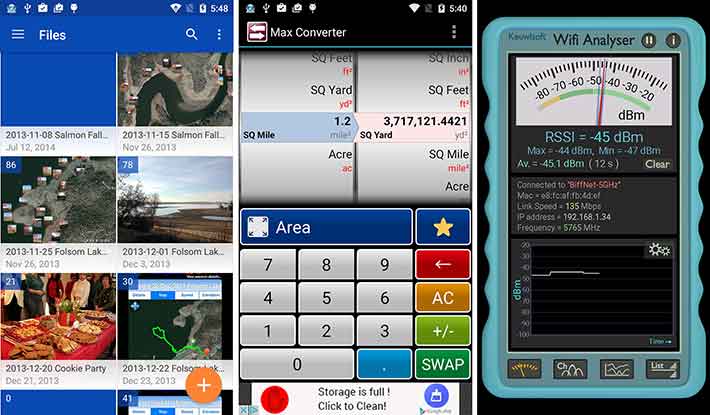
Powerful handhelds such as the Gladius GT-500 are also great platforms to record ideas and observations and perhaps do a quick sketch. We downloaded the electronic equivalent of a basic notepad (left) for typing in some notes when we didn't want to crank up MS Word, and we also like doodling notes (via apps like INKredible) or even do calligraphy, though that'd work better with the precision of a stylus. Having Skype on a device is pretty much mandatory.
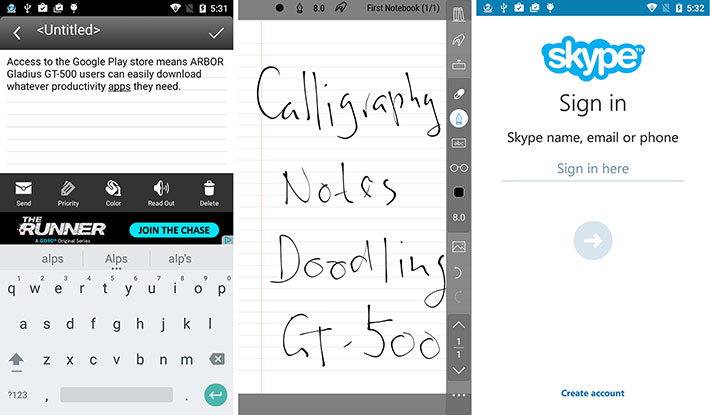
Next on the list of downloads might be Google Earth for mapping, satellite imagery, mapping with traffic information, or Street View. The fairly large size and high resolution of the Gladius GT-500 display makes mapping and GIS a natural for the device, and there's a large number of GPS apps that show satellite and location data.

Thanks to powerful GPS and various onboard sensors, the Gladius GT-500 is easily more competent for navigation and all sorts of positing and location services and applications than your run-of-the-mill vehicle GPS. Applications are endless.

The above is simply a very small sample of some of the useful everyday informational and productivity things the Gladius GT-500 can be used for. Thousands of other apps are available, on top of whatever custom or professional software users may wish to install.
Node Watch
 In our discussions with ARBOR, company representatives pointed out that mobile computing devices, thanks to their very rapid proliferation and increasing use in IoT (Internet of Things) applications, also represent an increasing tracking, control, management, configuration, and updating challenge. By the year 2020, there will be about 50 billion connected devices, seven times as many as the entire human population. In our discussions with ARBOR, company representatives pointed out that mobile computing devices, thanks to their very rapid proliferation and increasing use in IoT (Internet of Things) applications, also represent an increasing tracking, control, management, configuration, and updating challenge. By the year 2020, there will be about 50 billion connected devices, seven times as many as the entire human population.
To that extent, ARBOR developed their Node Watch cloud-based device management solution that provides full control over deployed mobile devices, enhancing security, simplifying configuration and updates, as well as reducing operational costs, allowing entirely new business models, and increasing sales revenue.
A rugged device management system using Node Watch could enable and disable individual devices, manage configurations, monitor device status, handle firmware upgrades, turn peripherals on and off, and deploy, activate, update and remove applications.
Accessories galore
With consumer tech, your choice of accessories is usually limited to protective cases (good thing, because they're needed!). Vertical market technology, on the other hand, usually comes with a whole ecosystem of productivity-enhancing gear. And that's certainly the case for the ARBOR GT-500.
Going clockwise, starting in the upper left, you see a) an ergonomically designed pistol grip with a scanner trigger, b) a quick release hand strap, c) the desktop cradle with a micro-USB port, d) a 4-in-1 battery charger with overheat detection and LEDs displaying charging status, e) a holster with handstrap, f) a UHF reader/data collector, and g) a vehicle dock.
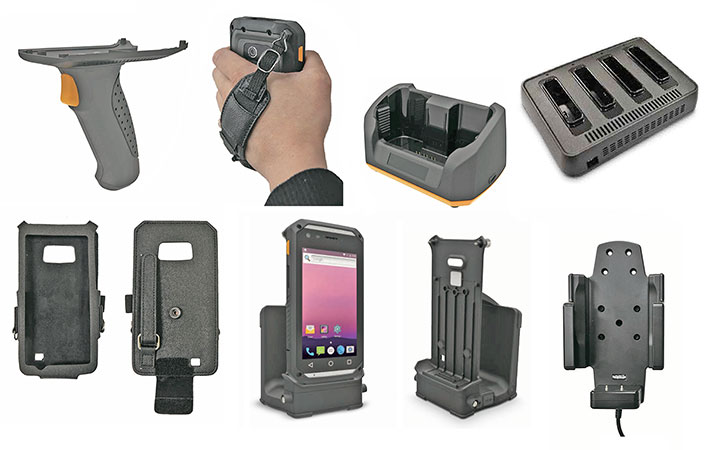
Don't underestimate the value of ready availability of accessories and peripherals made specifically for a productivity tool. Anyone who's dealt with the poor fit and often shoddy quality of 3rd party add-ons can attest to that.
Very good cameras
Like virtually every handheld these days, the ARBOR Gladius GT-500 has both a front and a rear camera. The front one is primarily for video calls and conferencing, and offers 2 megapixel resolution. The more powerful one in the rear is for documentation and general photography and uses a 13 megapixel imager. Camera settings allow selecting from four resolutions: 1, 4, 6 and 9.5mp. The test pictures we took at the highest setting came out in 4,096 x 2,304 pixel resolution, which is 9.5 megapixel. Both cameras can be used for stills as well as for video.
Cameras integrated into rugged vertical market handhelds and tablets has been underwhelming in the past (to say the least), with even the best ones lagging behind what's available in dedicated point & shoots and consumer smartphones. 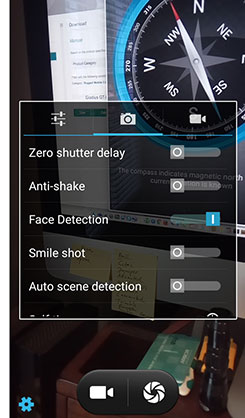 This is changing now, most likely driven by the demand of customers used to the excellent cameras built into consumer smartphones. And indeed, the rear-facing documentation camera of the Gladius GT-500 is very good. Not by DSLR standards, of course, but definitely more than up to the job of documentation whatever needs to be documented out there in the field. The test pictures we took with the device were very sharp and devoid of the frustrating over-compression of almost all older integrated cameras.
This is changing now, most likely driven by the demand of customers used to the excellent cameras built into consumer smartphones. And indeed, the rear-facing documentation camera of the Gladius GT-500 is very good. Not by DSLR standards, of course, but definitely more than up to the job of documentation whatever needs to be documented out there in the field. The test pictures we took with the device were very sharp and devoid of the frustrating over-compression of almost all older integrated cameras.
The screen snap to the right shows some of the camera settings screens, and what it looks like in picture-taking mode.
The user interface is quite elaborate, with 14 scene settings, 8 white balance settings, +/-3EV exposure control, face detection (including multi-face, smile-shot, etc.), anti-shake, 2/10 second self timer, 40 or 99 continuous shots, ISO settings from 100 to 1600 and auto, and more. Users can also set sharpness, hue, saturation, brightness and contrast to low, medium or high. Speed demons will like the zero shutter delay setting. The camera can shoot in HDR, multi-view, panorama, motion tracking, live photo, and picture-in-picture mode. We've come a very long way here.
Users can edit pictures right on the Gladius GT-500. There is a wealth of functions available, including 10 color effects, numerous frames, cropping, straightening, mirroring, numerous filters, and even such advanced operations as sharpening, hue, vibrance and curves. The camera app can also send images to Messaging, email, Skype, OneDrive or whatever other social media apps you have on the device. And images can also be converted to PDF.
In video mode, there is a special meeting recording setting for audio recording, and the microphone can be turned on and off. There is also time lapse video with a picture taken shot every one to 10 seconds, and users can set video quality to low, medium, high and fine. Noise reduction is available as well.
Having all those many settings and features available will be important to some users, but what's most impressive about the Gladius camera apart is its speed and quality. It is well suitable to document jobs both in stills and in video.
The pictures below were shot with the ARBOR Gladius GT-500 in 9.5mp mode. Click on the image to bring up a full-size version.

The Gladius 5 camera is capable of taking much better pictures than we generally see from industrial handhelds. There is very good sharpness and image detail, and little of the massive compression that often renders pictures from such integrated cameras useless.
Video is also much better than what we've come to expect from cameras integrated into rugged devices. Frame rate and focussing are quick and the camera doesn't fall behind. The maximum 1920 x 1080 pixel 1080p recording format is very useful. We wish, though, that recording size could be selected directly, rather than via the "low, medium, high and fine" quality options.
The video to the right was taken with the Gladius GT-500 camera. It's an example of a clip that an automotive mechanic or tuner might shoot as an attachment to a work order.
Note that the camera applications that come with mobile operating systems are often replaced with third party applications optimized for certain tasks, or developers and systems integrators include camera and video functionality directly into custom applications.
In summary, the still image and video functions of the Gladius GT-500 are plenty good enough for virtually any documentation jobs.
Seriously tough and rugged
While ARBOR's thinner and lighter Gladius 5 hides its inherent strength in an elegant and deceivingly smartphone-esque design, no one will doubt the GT-500's ruggedness. This is a substantial, solid handheld computer. And its ruggedness specs are impressive.
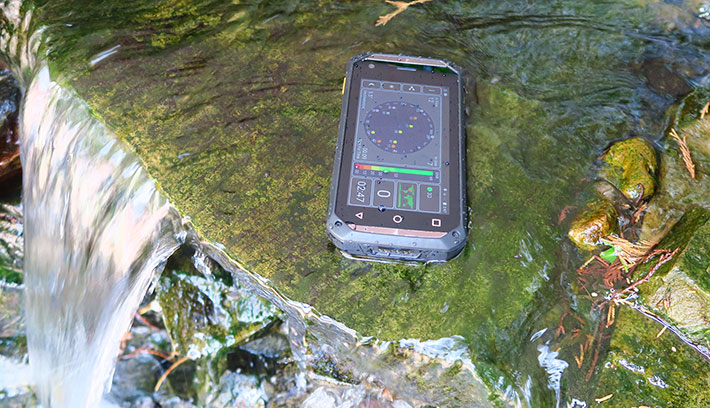
To fend off the elements, the Gladius GT-500 carries IP67 sealing where the "6" means it's completely dustproof, and the "7" that it is also sealed against, according to the IP classification system chart, the effects of immersion into water down to about a meter. That means the GT-500 can easily survive not only rain or a good hosing down, but also a drop into a puddle or even a stream. No one, of course, will intentionally drop a valuable tool for the job into water, but it can happen, and then it's better to have an IP67-sealed device than one that only goes to IP65, like the Gladius 5.
The device can also handle drops from five feet. Consumer smartphones may survive a four foot drop inside a third party case, and even then there are no guarantees that they can survive a drop, let alone multiple drops. Five feet is more than dropping a device while using it with your hands while walking (about four feet), so there's an extra reserve.
The stated operating temperature range of 5 to 131 degrees Fahrenheit (-15 to 55 degrees Celsius) is wide enough to allow the device to be used virtually anywhere.
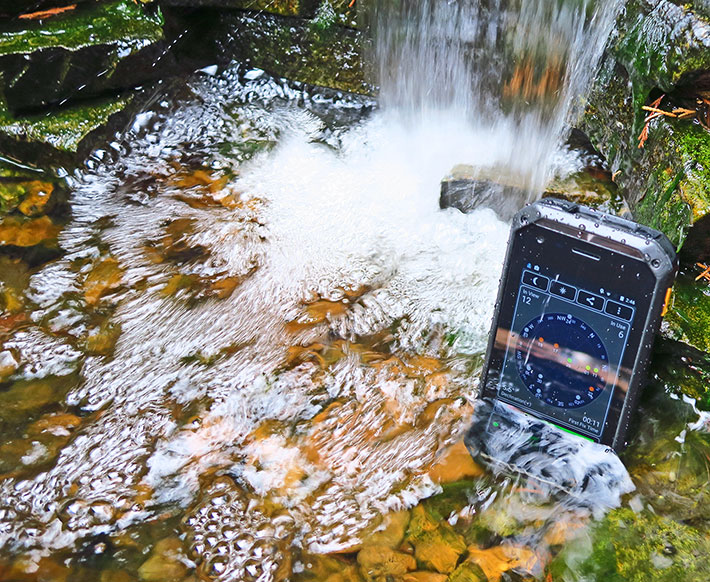
The impressive strength provided by the GT-500's internal magnesium frame suggests a high degree of toughness and ability to withstand accidents and abuse. And the device does feel absolutely rock-solid. External ports all have tight-fitting protective rubber plugs with their own replaceable o-ring seals.
However, while ARBOR's literature mentions MIL-STD-810G certification, it does not say which MIL-STD-810G or similar tests, specifically, have been performed. Vibration, for example, can be a big issue if a device rattles around in a vehicle or if it's mounted on something that vibrates a lot. Users may also want to know its ability to handle tumbles, altitude, shock, shielding, and perhaps salt fog resistance and so on. We'd encourage ARBOR to make the results of such tests available in its sales literature.
That said, we're confident that the ARBOR Gladius GT-500 will hold up very well in the field and under tough conditions. Its structure and design are exceptional, its sealing is well thought-out, and we didn't hesitate to dunk the device in our testing. But we'd still like to see more official test results.
Summary: ARBOR Gladius GT-500 — tough and rugged Android mobile computer for worldwide deployment
While ARBOR Technology Corp. already has the sleek 5.5-inch Gladius 5, with the Gladius GT-500 the company offers a more substantial, more field-oriented Android 7-based handheld computing device for tough jobs in even the most challenging environments.
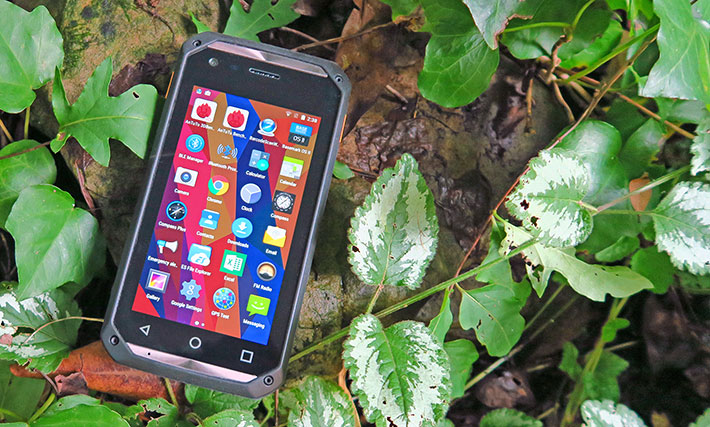
IP67 sealing means the GT-500 is totally dustproof and can even handle total immersion in water. It can survive 5-foot drops thanks to its tough internal magnesium frame and substantial external protection. Despite its solid build, the GT-500 remains compact, pocketable, and suitable for one-handed operation. 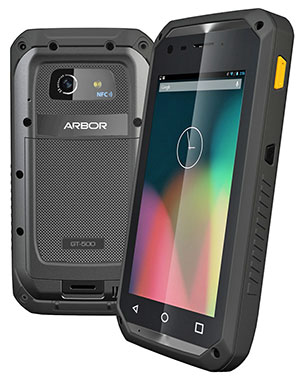
Sporting a spacious large, bright, and very sharp (294 dpi) 5.0-inch capacitive multi-touch display means the Gladius GT-500 has enough screen real estate for complex applications, and enough sharpness for even minute details. The large replaceable battery should last well beyond a full shift.
Built around the MediaTek "WorldMode" MT6735 smartphone platform, the dual-SIM Gladius GT-500 merges 2G, 3G and 4G communication technologies and is capable of seamlessly roaming across high-speed 4G LTE networks uninterrupted.
For applications that require extensive data collection, the Gladius GT-500 is available with an integrated 1D/2D barcode scanner. There's a 13-megapixel documentation camera and a 2-megapixel frontal camera for video conferencing. There's also NFC, dual-band WiFi, GPS and Bluetooth 4.1.
With the Android-powered Gladius GT-500, ARBOR provides a rugged, rock-solid handheld computer that's large and powerful enough for any job, yet still small and light enough to go anywhere, and, thanks to its WorldMode technology, communicate anywhere. -- Conrad H. Blickenstorfer, July 2016/April 2018
ARBOR Gladius GT-500/GT-500-V Specs:
| Added/changed |
Added 06/2016, full review 07/2016, updated 12/2017, 01/2018, 04/2018
|
| Type |
Rugged Android handheld
|
| Processor |
1.30GHz Quad-core MTK MT6735 Cortex-A53
|
| Graphics |
ARM Mali-T720 GPU
|
| OS |
Android 5.1 (Android 7.0 "Nougat" as of January 2018)
|
| Standard/Max RAM |
GT-500: 2GB LPDDR2
GT-500-V: 3GB LPDDR2 |
| Disk/drive |
16GB eMMC onboard, plus microSD card storage (up to 32GB) |
| Display type |
TFT, 500 nits |
| Display size/resolution |
5.0-inch, 1280 x 720 pixel, 294 ppi (pixels per inch) |
| Digitizer |
5-point projected capacitive multi-touch, glove-capable |
| Keyboard/keys |
Onscreen
|
| Navigation |
Touch
|
| Expansion slots |
GT-500: 1 x microSDHC Card (up to 32GB), 2 x micro-SIM card (one 2G only, one 2G/3G/LTE)
GT-500:V: 1 x microSDHC Card (up to 64GB), 1 x micro-SIM card
|
| Housing |
PC+ABS polymer over magnesium frame
|
| Size |
3.4 x 6.5 x 1.0 inches (86 x 166 x 26 mm)
|
| Weight |
13.6 oz. (385 grams) with battery
|
| Operating temperature |
GT-500: 5° to 131°F (-15° to 55°C)
GT-500-V: 14° to 122°F (-10° to 50°C) |
| Ingress protection |
IP67 (totally dustproof, sealed against full immersion to 3.3 feet) |
| Humidity |
5-95% non-condensing |
| Drop |
5-foot drops |
| Vibration |
MIL-STD-810G testing |
| Altitude |
Unknown |
| Tumble |
Unknown |
| ESD |
Unknown |
| Power |
GT-500: 3.7V, 4,800mAh 17.8 watt-hour ("up to 8 hours")
GT-500-V: 3.7V, 5,200mAh 19.2 watt-hour; optional high-capacity 7,800mAh battery |
| Camera |
GT-500: Front: 2.0mp, rear: AF 13mp with LED
GT-500: Front: 5.0mp, rear: AF 13mp with LED
|
| GPS |
Yes |
| Scanner |
Zebra SE4710 1D/2D imager with physical trigger buttons |
| Sensors |
Ambient light, proximity, 3-axis accelerometer, 3-axis magnetic field, barometer |
| Communication |
GT-500: Dual-band 802.11a/b/g/n, Bluetooth 4.1 BLE/HS, NFC, 2G GSM/GPRS/EDGE, 3G WCDMA/CDMA2000, 4G FDD+TDD, 4G DRX, GPS/GNSS/Beidou, 1D/2D imager with physical trigger
GT-500-V: Dual-band 802.11a/b/g/n, Bluetooth 4.1 BLE/HS, NFC, LTE (B2/B4/B13),
HSPA+ (fallback: Release 9 & Category 24 on B2), GPS, 1D/2D imager with physical trigger
|
| Interface |
1 x micro USB 2.0, audio in/out, dock |
| Price |
Starting at US$??? |
| Spec sheet |
 Gladius GT-500 brochure (PDF) Gladius GT-500 brochure (PDF)
 Gladius GT-500 brochure (PDF) Gladius GT-500 brochure (PDF)
|
| Web page |
 Gladius GT-500 web page Gladius GT-500 web page
 Gladius GT-500-V web page Gladius GT-500-V web page |
| Contact |
ARBOR Technology Corp.
10F., No.700, Zhongzheng Rd.
Zhonghe Dist., New Taipei City 235
Taiwan, R.O.C.
Tel: 886 2 8226 9396
Fax: 886 2 8226 9398 |
|



